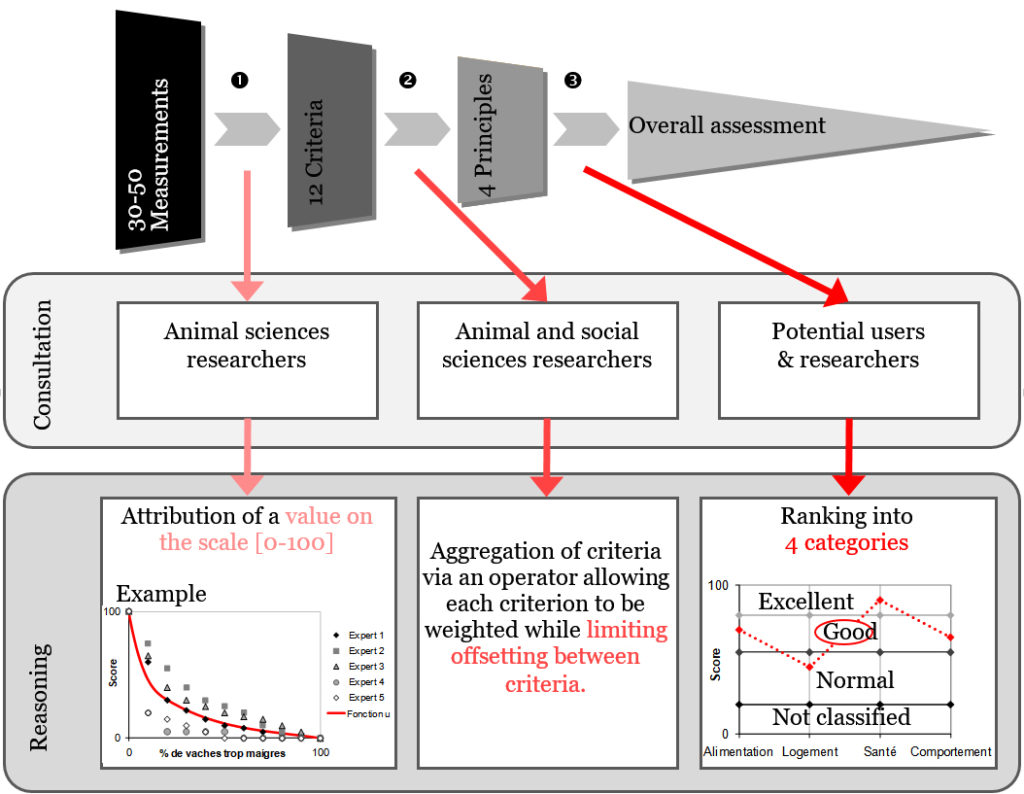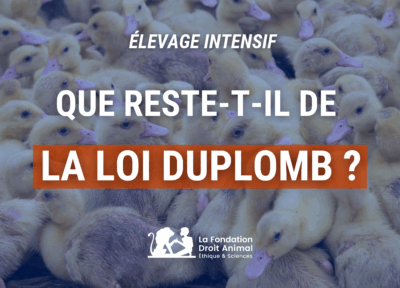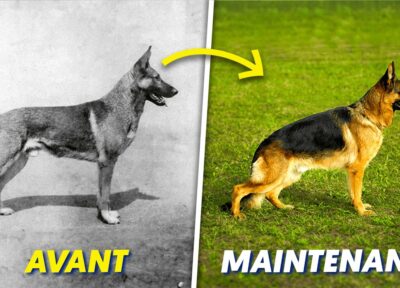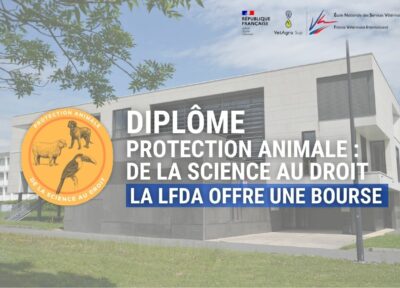by Isabelle Veissierª & Raphaëlle Botreaub
aINRA, Centre-Auvergne-Rhône-Alpes, France
bClermont University, VetAgro Sup, INRA, Centre-Auvergne-Rhône-Alpes, France
[DOWNLOAD ARTICLE] [Download complete PDF 6.2Mo]
To cite this article (suggested): Veissier I. & Botreau R., « Evaluation of animal welfare: the weight of words and the power of numbers » [PDF file], In: Hild S. & Schweitzer L. (Eds), Animal Welfare: From Science to Law, 2019, pp.33-39.
Why assess animal welfare?
European consumers feel insufficiently informed about the welfare of the animals used to make the products they buy (European Commission, 2005 & 2007). Agriculture and food companies’ responsibility now includes the protection of animals (Amos & Sullivan, 2013). A number of European conventions to protect animals have been adopted by the Council of Europe since the 1970s. These have been followed by European Union directives or regulations on the protection of animals. The UK’s Farm Animal Welfare Council defines animal welfare in terms of five freedoms: freedom from hunger or thirst; freedom from physical discomfort; freedom from pain, injury or disease; freedom to express normal behaviour; freedom from fear and distress (Farm Animal Welfare Council, 1992). The five freedoms are widely used to make recommendations, set regulations or design certification systems. Economic actors and animal protection associations have developed systems that fulfil animal welfare requirements on this basis and have begun using animal welfare claims (for instance the Freedom Food initiative in the United Kingdom and Beter Leven in The Netherlands). Most of the certifications are based on obligations of means that can be quite easily measured (minimum surface area per animal, food, enrichment of the environment, etc.). Yet these obligations do not necessarily have a significant outcome for the animal (Main et al., 2007). It was thus necessary to improve and harmonise the evaluation of animal welfare in order to ensure that these types of initiatives are acknowledged by citizens and create fair trading conditions. The European Welfare Quality® project (2004-2009) aimed to propose a tool to assess the welfare of animals in farms and in slaughterhouses (cattle, pigs and poultry); this tool was to be used to provide advice on farming practices and to adhere to certification programmes.
Much has already been written about the Welfare Quality® project. This paper does not aim to detail the Welfare Quality® assessment system in full but rather assess its impact.
Defining welfare criteria
Welfare is a multidimensional concept that includes both physical and mental health as well as other aspects such as physical comfort, the absence of hunger, the ability to express normal behaviour, etc. The five freedoms defined by the Farm Animal Welfare Council provide an operational framework for understanding the various aspects of animal welfare and applying these to various types of animal husbandry. They place relatively precise words on a protean concept. Nevertheless, certain freedoms cover specific functional aspects, such as the absence of hunger or thirst. So that the full scope of animal welfare was taken into account, the Welfare Quality® project partners derived 12 welfare criteria from the five freedoms (Botreau et al., 2007):
- Animals should not suffer from prolonged hunger, i.e. they should have a sufficient and appropriate diet.
- Animals should not suffer from prolonged thirst, i.e. they should have a sufficient, accessible water supply.
- Animals should have comfort around resting.
- Animals should have thermal comfort, i.e. they should neither be too hot nor too cold.
- Animals should have enough space to move around freely.
- Animals should be free from physical injuries.
- Animals should be free of disease, i.e. farmers should maintain high standards of hygiene and care.
- Animals should not suffer pain induced by inappropriate management, handling, slaughter, or surgical procedures (e.g. castration, dehorning).
- Animals should be able to express normal, non-harmful social behaviours, e.g. grooming.
- Animals should be able to express other normal behaviours, i.e. it should be possible to express species-specific natural behaviours such as foraging.
- Animals should be handled well in all situations, i.e. handlers should promote good human-animal relationships.
- Negative emotions such as fear, distress, frustration and apathy should be avoided and positive emotions such as security, comfort or contentment should be promoted.
These 12 criteria were used to identify indicators to consider when assessing a farm or a slaughterhouse.
Animal-based measures to assess welfare
Today, it is widely acknowledged that animals are sentient beings (see for example the European Convention for the Protection of Animals Kept for Farming Purposes (Council of Europe, 1976), the European Union Treaty of Amsterdam (1997), or the recent recognition of animal sentience in the French Civil Code (Article 515-14 of the Civil Code, Act No. 2015-177 of 16/02/2015). This recognition was the starting point for a change in the way the protection of animals is represented: instead of thinking what could be good for animals from our human point of view (meaning good treatment), the question is now asked in terms of what the animals feel. Welfare comes from what an animal feels, even if this is hard to assess.
It is possible to show that animals have preferences and feel emotions (Dawkins, 1983; Boissy et al., 2007; Veissier et al., 2009). Animal-based indicators have been developed to assess what matters to animals: preference tests, stress tests, behaviour, etc. In addition, animal welfare depends on several factors: housing, nutrition, care, etc. These factors can be easily measured but their combined impact on the animal is difficult to predict. Using animal-based indicators (its state, its behaviour, etc.) provides a more comprehensive view of the animal’s welfare (regardless of the reasons why this welfare may have been altered or improved). These animal-based indicators can show us how animals perceive their environment and help us assess whether it provides them with good or poor living conditions. This is why the Welfare Quality® assessment system focuses on animal-based indicators. This does not mean always looking at what the animal feels but it means at least considering the impact that its environment (housing, nutrition, care, social environment, etc.) has on it, assuming that what the animal feels largely depends on these impacts. When such indicators are not available, the Welfare Quality® assessment looks at indicators based on the animal’s environment (Table 1). All these indicators can be measured at a farm or slaughterhouse.
Table 1: The 12 criteria of animal welfare (Welfare Quality®, 2009)
|
Criteria |
Indicators for dairy cows |
Type of indicator |
|
Absence of prolonged hunger |
Physical state |
Animal |
|
Absence of prolonged thirst |
Number and cleanliness of water points |
Environment |
|
Comfort around resting |
Behaviour around resting, cleanliness of animals |
Animal |
|
Thermal comfort |
No available measure for adult cattle |
|
|
Ease of movement |
Access to an exercise area (pasture or other) |
Environment |
|
Absence of injuries |
Lameness, external lesions |
Animal |
|
Absence of disease |
Clinical observations: cough; nasal, ocular or vulval discharge; diarrhoea Documentation: somatic cell counts, mortality, dystocia, « downer cow » syndrome |
Animal |
|
Absence of pain induced by management procedures |
Dehorning |
Environment |
|
Expression of social behaviours |
Aggressive interaction |
Animal |
|
Expression of other welfare-related behaviours |
Access to pasture |
Environment |
|
Good human-animal relationship |
Flight distance from humans |
Animal |
|
Positive emotional state |
Qualitative assessment of behaviour |
Animal |
Scoring reflects ethical choices
The Welfare Quality® project’s goal was to provide a standard for the assessment of animal welfare. To assess an object means making a judgement of that object. Therefore, we needed to summarise data collected from various indicators used on farms (or in slaughterhouses) and be able to make a judgement of this farm or slaughterhouse, namely for each indicator we had to define the values for which the level of welfare could be deemed to be high or low. This exercise raises several ethical questions:
- To judge overall animal welfare at herd level, should we use the herd’s average level of welfare or concentrate on the worst-off animals? If we were assessing country wealth, it would be the equivalent of looking at average income in one case and the percentage of the population living under the poverty line in the other.
- Can one aspect of welfare compensate for another? For instance, if the animal is in good health, can we accept that it cannot express normal behaviour?
- Should the judgement be based on what in theory corresponds to a good level of welfare or what can be achieved in practice? In the first case, we would set limits beyond which the level of welfare would be deemed to be unacceptable, and in the other case, we would ask, for example, the farms ranked in the lowest 20% to improve regardless of the level of welfare provided by the other 80% of farms.
These questions have led to much debate between project researchers and external actors (farmers, other economic actors, citizens) (Miele et al., 2011; Veissier et al., 2011) eventually resulting in the following scoring system:
- measurements collected on farms or at slaughter are transformed into scores on a scale of 0 to 100 (0 being a very poor state of welfare and 100 being an excellent state) with a score for each of the 12 welfare criteria;
- these criteria are then integrated into four principles (good feeding, good housing, good health, appropriate behaviour) and the criteria scores are aggregated into principle scores;
- finally, the scores obtained by a farm or slaughterhouse for the four principles are used to place it into one of the four categories defined according to the animals’ welfare: excellent, enhanced, acceptable and not classified (Figure 1).
Scoring methods are defined so that:
- priority is placed on the worst-off animals; the average level of welfare of the herd has a lesser impact,
- each criterion is weighted but there is very little offsetting between criteria,
- the final classification of a farm reflects not only a theoretical acknowledgement of what can be considered excellent, good or acceptable, but also what can realistically be achieved in practice.
For more details please refer to Veissier et al. (2010).

Figure 1: Construction of the Welfare Quality® assessment system (according to Veissier et al., 2010)
Widespread dissemination of Welfare Quality® project outcomes
The principles developed by Welfare Quality® have been adopted by various actors:
- Welfare Quality® has served as a base for the development of other systems to assess welfare in small ruminants, turkeys, equids, dogs and cats, fur animals and even marine mammals (Ahola et al., 2015; AWIN, 2015a and 2015b and 2015c and 2015d and 2015e; Clegg et al., 2015; Møller et al., 2015).
- Welfare Quality® has also led to discussions among various public decision-makers. In its Community Action Plan on the Protection and Welfare of Animals 2006-2010, the European Union expressed its intention to change from a means-based approach (using environmental indicators) to an outcome-based approach (using animal-based indicators) (European Union Commission, 2006). Some animal-based indicators are already used in regulations governing slaughter (EC No. 1099/2009: the efficiency of stunning must be checked before bleeding). The willingness to use animal-based indicators was reinforced in the 2012-2015 community action plan (European Commission DG-Sanco, 2012). Additionally, the EFSA (European Food Safety Authority) has created a programme to list which animal-based indicators can be routinely collected (EFSA, 2015).
- Several firms are interested in the Welfare Quality® project as a tool for creating dialogue between buyers, suppliers and consumers. Danone has thus created an animal welfare programme using Welfare Quality® indicators (Danone and Phyllum, 2012) combined with a self-testing sheet for dairy farmers. In Spain, AENOR (Spanish Association for Standardization, equivalent of AFNOR in France) presented the ATO standard for marketing milk from farms assessed using the Welfare Quality®
These are just a few examples of the impact the project has had. Its impact has undoubtedly been far wider. Welfare Quality® is well known outside Europe, as demonstrated by discussions with researchers from other continents and the OIE’s adoption of animal-based indicators.
The reasons for success
Societal expectations regarding the protection of animals existed before research began looking into animal welfare. However, at the end of the 20th century, animal welfare was still a vague concept that needed both a general definition (e.g. mental and physical health or quality of life as perceived by the animal) and an operational definition (e.g. the five freedoms or the 12 Welfare Quality® criteria). These definitions gave more credibility to researchers looking at the issue of animal welfare. In turn, indicators produced by this research made it possible to examine animal welfare in practice. This has encouraged dialogue between stakeholders, scientists and society at large. The first step was to put the ideas into words and then share these words in order to be able to discuss the issue.
The Welfare Quality® project has been very much in the public eye. Admittedly, there was an intensive communication campaign: website, conferences, popular science reviews, focus groups and citizen juries, etc., all orchestrated by a very efficient communication officer. The fact that the 12 criteria offer an operational framework for understanding the issue of animal welfare in terms of their living conditions has facilitated dialogue between citizens and producers, public decision-makers and scientists. The strength of the Welfare Quality® project probably also comes from the fact that it not only produces words but also numbers:
- indicator-related numbers (percentage of lame cows in a herd, frequency of interaction between animals, number of days spent outside, etc.);
- numbers on compliance with criteria and principles (criteria and principle scoring on a scale of 0 to 100) and overall classification of each farm into one of four categories.
In our societies where assessment often relies on quantitative measures, numbers are particularly important. High-school students are graded on their end-of-school exams; the quality of the school is assessed by the percentage of students that pass; researchers are assessed on the number of papers they publish; the police force is assessed by how many cases it investigates, etc. It is evident that we live in a world of numbers. Nothing seems more serious than a number! Welfare Quality® calculations were used by the project’s partners as a means to generate an overall assessment, not an end in itself. Even though this was not the original intention, the Welfare Quality® calculations and scores likely added to its credibility. On the contrary, it could have helped its detractors undermine that credibility.
The use of animal-based measures should not exclude the definition of minimal prescriptive norms. The risk of only using animal-based measures would be the (re)introduction of farming systems that, by definition, do not respect animal welfare (e.g. battery chickens or veal calves in individual cages), on the pretext that the level of welfare of the animals living there will be checked at a later stage. This prompted the Welfare Quality® partners to state the need to « ban the bad systems and assess the good ones » (Blokhuis, 2013). This means taking a pragmatic approach by combining any measures that would bring about improvements to welfare, whether by promoting suitable environments or monitoring animal welfare (Main & al., 2014).
References
Ahola L, Botreau R, Gaborit M, Hovland AL, Koistinen T and Mononen J 2015. WelFur – Welfare assessment protocol for foxes. FurEurope, Bruxelles (BEL)
Amos N and Sullivan R 2013. The Business Benchmark on Farm Animal Welfare: 2013 Report.
Anonyme 1997. Traité d’Amsterdam modifiant le traité sur l’Union européenne, les traités instituant les communautés européennes et certains actes connexes. Journal officiel n° C 340 du 10 Novembre 1997.
AWIN 2015a. AWIN welfare assessment protocole for turkeys.
AWIN 2015b. AWIN welfare assessment protocole for Sheep.
AWIN 2015c. AWIN welfare assessment protocole for goats.
AWIN 2015d. AWIN welfare assessment protocole for horses.
AWIN 2015e. AWIN welfare assessment protocole for donkeys.
Blokhuis H, Miele, M., Veissier, I., Jones, B. (eds.) (NL). 2013. Improving Farm Animal Welfare: Science and Society Working Together: The Welfare Quality Approach. Wageningen Academic Publishers, Wageningen.
Boissy A, Manteuffel G, Jensen MB, Moe RO, Spruijt B, Keeling L, Winckler C, Forkman B, Dimitrov I, Langbein J, Bakken M, Veissier I and Aubert A 2007. Assessment of positive emotions in animals to improve their welfare. Physiology and Behavior 92, 375-397.
Botreau R, Veissier I, Butterworth A, Bracke MB and Keeling LJ 2007. Definition of criteria for overall assessment of animal welfare. Animal Welfare 16: 225-228.
Clegg I, Borger-Turner J and Eskelinen H 2015. C-Well: The development of a welfare assessment index for captive bottlenose dolphins (Tursiops truncatus). Animal welfare 24, 267-282.
Commission de l’Union Européenne 2006. Amélioration du bien-etre des animaux: adoption d’un plan d’action de l’Union Européenne / Improving animal welfare: EU action plan adopted.
Council of Europe 1976. European Convention for the Protection of Animals Kept for Farming Purposes. Treaty No.087 Strasbourg, 10-03-1976.
Danone and Phyllum 2012. DANONE Dairy Animal Welfare Program. Danone.
Dawkins MS 1983. Battery hens name their price: consumer demand theory and the measurement of ethological « needs ». Animal Behaviour 31, 1195-1205.
EFSA (European Food Safety Authority) 2015. EFSA’s internal project on the use of animal-based measures to assess animal welfare in EU – state of art of the 10 years of activities and analysis of the gaps. EFSA supporting publication 2015: EN-884, 21 pp.
European Commission 2005. Attitudes of consumers towards the welfare of farmed animals. Special Eurobarometer 229/Wave 63.2 – TNS opinion and social.
European Commission 2007. Attitudes of consummers towards the welfare of farmed animals – Wave 2. Special Eurobarometer 229(2)/Wave 64.4 – TNS Opinion & Social.
European Commission DG-Sanco 2012. European Union Strategy for the Protection and Welfare of Animals 2012-2015. 20 January 2012.
Farm Animal Welfare Council 1992. FAWC updates the five freedoms. Veterinary Record (The) 17, 357.
Main DCJ, Whay HR, Leeb C and Webster AJF 2007. Formal animal-based welfare assessment in UK certification schemes. Animal Welfare 16, 233-236.
Main DCJ, Mullan S, Atkinson C, Cooper M, Wrathall JHM and Blokhuis HJ 2014. Best practice framework for animal welfare certification schemes. Trends in Food Science & Technology 37(2), 127-136.
Miele M, Veissier I, Evans A and Botreau R 2011. Animal welfare: establishing a dialogue between science and society. Animal Welfare 20, 103-117.
Møller SH, Hansen SW, Malmkvist J, Vinke CM, Lidfors L, Gaborit M and Botreau R 2015. WelFur – Welfare assessment protocol for mink. FurEurope, Bruxelles (BEL).
Veissier I, Botrau R and Perny P 2010. Evaluation multicritère appliquée au bien-être des animaux en ferme ou à l’abattoir : difficultés et solutions du projet Welfare Quality®. Inra Productions Animales 23, 269-284.
Veissier I, Boissy A, Désiré L and Greiveldinger L 2009. Animals’ emotions: studies in sheep using appraisal theories. Animal Wefare 18, 347-354.
Veissier I, Jensen KK, Botreau R and Sandoe P 2011. Highlighting ethical decisions underlying the scoring of animal welfare in the Welfare Quality (R) scheme. Animal Welfare 20, 89-101.
Welfare Quality® 2009. Welfare Quality® assessment protocol for cattle (fattening cattle, dairy cows, veal calves). Welfare Quality® Consortium, Lelystad, The Netherlands.




